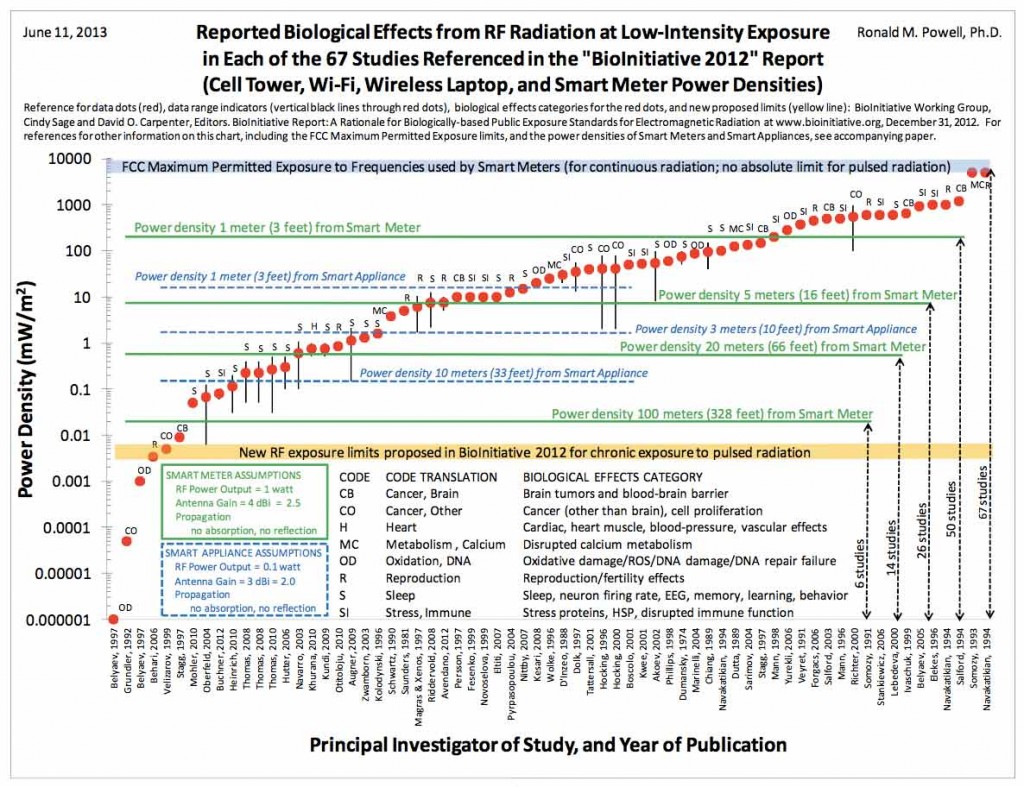 Applied physicist and Harvard PhD, Dr Ronald M Powell, has authored a very useful document showing the harmful effects of electromagnetic radiation in the context of Smart Meters.
Applied physicist and Harvard PhD, Dr Ronald M Powell, has authored a very useful document showing the harmful effects of electromagnetic radiation in the context of Smart Meters.
Of particular note is the Biological Effects Chart which Dr. Powell presents – providing a succinct graphical representation of data taken from Bioinitiative 2012 – an extensive review of the medical research literature on the biological effects from electromagnetic fields. The purpose of the Chart is to show the radiofrequency (RF) exposure levels at which biological effects were found in 67 studies from the RF Color Charts of the BioInitiative 2012 Report, and then to compare those exposure levels to the following:
(1) current FCC Maximum Permitted Exposure (MPE) limits that govern Smart Meters and Smart Appliances in the United States [note that by understanding that UK exposure limits are based on ICNIRP standards it is also easy to compare exposure levels from a UK perspective – Ed.]
(2) new biologically based RF exposure limits proposed in the BioInitiative 2012 Report
(3) calculated RF exposure levels produced by a single Smart Meter at various distances
(4) calculated RF exposure levels produced by a single Smart Appliance at various distances
In the report, Powell explains that the comparison indicates the following:
(1) The current FCC Maximum Permitted Exposure (MPE) limits are so high that they provide no protection for the public from the biological effects found in any of the 67 studies [by implication the UK MPE limits likewise provide no protection – Ed.]
(2) New biologically based RF exposure limits proposed in the BioInitiative 2012 Report are 1 million times lower than current FCC limits and would protect against the biological effects found in nearly all of the 67 studies.
(3) A single Smart Meter on a home can produce RF exposure levels that caused the biological effects found in either most or many of the 67 studies, depending on the distance from the Smart Meter.
(4) A single Smart Appliance in the home can produce RF exposure levels that caused the biological effects found in nearly half or fewer of the 67 studies, depending on the distance from the Smart Appliance. Multiple Smart Appliances in a home multiply the total exposure.
(5) A single Smart Meter on a nearest neighbor’s home can produce RF exposure levels that caused the biological effects found in many of the 67 studies. A given home may have one to eight nearest neighbors, each with a Smart Meter, multiplying the total exposure in the given home.
Other observations:
(1) Most biological effects of RF exposure cannot be sensed by human beings. Examples are the onset of cancer, DNA damage, and fertility effects. One category of effects that can often be sensed includes neurological effects on sleep, memory, learning and behavior.
(2) Unborn and very young children may be more affected by RF exposure than adults. This document provides background information, an explanation of each feature of the Biological Effects Chart, and a detailed discussion of each of the conclusions and observations summarized above.
The report can be downloaded here: http://marylandsmartmeterawareness.org/wp-content/uploads/2013/06/Biological_Effects_from_RF_Radiation_and-Implications_for_Smart_Meters_June_11_2013_B.pdf

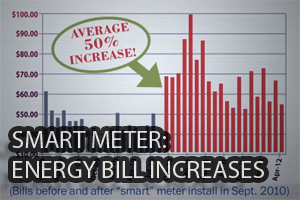
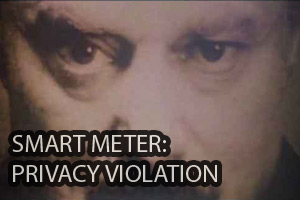





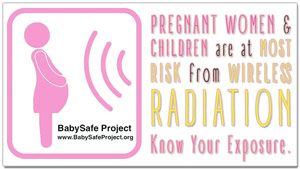

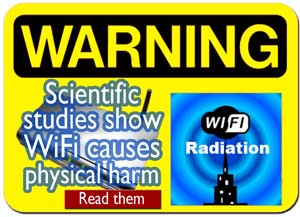
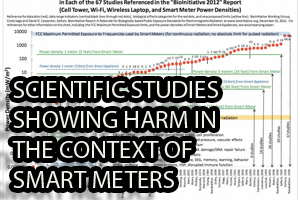



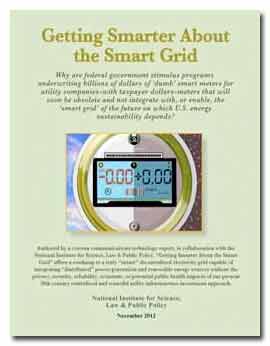

I would like to see a list of MP’s who have a financial interest in smart meters.
It would be extremely interesting to find out exactly which companies public sector and MP pension funds are invested in too.
Yes, that’s exactly what I want to know.
A good person to speak to about this might be Donnachadh McCarthy FRSA, an award-winning environmentalist, who I think can be contacted via a consultancy he set up “3 Acorns Eco-Audits”.
I met him in July when he gave a talk entitled “How to Save the Planet from the Prostitute State” and was impressed by his integrity and courage. I believe he has made a study of previous and current MPs who are currently paid lobbyists for business interests. He has a facebook page which can be followed. I don’t currently have the energy to raise the whole wasp’s nest of a subject of smart metres with him but maybe someone else could?
1) Smart meters do not transmit continuously, only when they have data or instructions to pass to another part of the system. A duty cycle factor should be included in the calculation.
2) A transmitter power of 1W is assumed. Given that a battery life of ten years is being aimed at, this would suggest a capacity of 90kWh (not factoring in the efficiencies of the transmitted circuit). That would be a BIG battery! (A standard car battery holds about 1kWh.) This would require 30000 rechargeable AA cells. Methinks that the assumptions are out by at least three orders of magnitude.
3) An antenna gain has been included in the calculations. Gain applies where a directional antenna is used and unless the antenna is designed to form a ‘beam’ and someone stands in that bean, the radiation will be /*less*/ than the isotropic value. This 3 or 4bD gain should be removed from the calculation and assumptions.
Without going into a fuller deconstruction of this scaremongering, these points should clearly show that the radiation levels are very much lower than suggested and by about five meters away from a smart meter the power density is below the yellow Bioinitiative 2012 level.
Dear Andy,
1. Smart Meters DO transmit continuously (at least the ones that we have measured and taken reference of) – we are aware of only two exceptions, which are generally not compliant with UK SMETS II standards. To give you an example, see here: https://www.facebook.com/photo.php?v=10151526181142813 this is a British Gas Smart Meter emitting 43,000 pulses per day. Court documents from the US showed that some Smart Meters can emit up to 190,000 pulses PER DAY. We’d say the word “constant” applies here – because the pulses are constant and chronic.
2. Your assumption about transmitter power may be correct in some cases – however, here is a story which discusses the Smart Meters Thames Water is engaged in rolling out here in the UK currently: http://www.computerworlduk.com/news/infrastructure/3341106/thames-water-trials-wireless-smart-meters/. In it, they reference their partner, Sensus – and if you look at the equipment Sensus install here: http://sensus.com/web/usca/electric/product-line/smart-grid-communications-network … they describe using an “industry-leading” 30W of power – 30 times higher than your assumption. If you calculate your battery requirements for that, you’ll probably need an even bigger battery – or, more likely, one that is relatively small that can be changed when required.
3. We will need to look into the antenna design – however, we do not believe that it is possible for any utility or energy company to ensure people, plants or animals are a minimum of five meters away from a Smart Meter – until they can, we think they should be halted.
Thank you for your interest in our campaign.
Thanks for the reply and links.
1) I agree that every two seconds is unrelenting but it is not constant and a burst of a few milliseconds every two seconds brings the effective power transmitted down to a few milliwatts.
2) The Sensus equipment you reference is using “licensed frequencies”, which means that it is not the 2G4Hz ZigBee/WiFi band and is more likely to be in the UHF or even VHF range. In this case, the base station can receive from 40 000 ‘endpoints’, which means that each endpoint (ie, unit at a dwelling or other building) can only be transmitting 1/40 000th of the time at maximum and likely to be less than half that due to having to receive instructions from the base station and switch to transmit mode. That brings the average transmitted power down to a maximum of a third of a milliwatt. If these units are battery powered, they will be designed to have a very low energy use, averaging a microwatt or so. This would still require a 2500mAh battery at 12V to be replaced/charged each year. A water meter will not need to transmit a reading more than a few times per day.
3) My calculation of 5m was not to say that this is the minimum distance to keep away from such units but merely to show that once corrected for the clearest of over-estimations, the radiation levels are very much within the safe zone suggested by Bioinitiative 2012 for most normal situations.
Perhaps a good route would be to develop some ‘dose meters’ similar to those used in the nuclear industry to measure actual exposure in real life situations.
Given that the [main] ZigBee signals are using the same frequency band that many households [voluntarily] use for WiFi (2G4Hz) and that the data rates are 40 to 200 times lower (250kb/s vs 11-50Mb/s), the power flux will be similarly lower even if you ignore the fact that many WiFi devices (laptops, smart phones, tablets) are held much closer to the human body than any of the smart meter components with the possible exception of the In Home Display, which is not allowed to consume (let alone transmit) more than 600mW of power on average.
I would agree that not all RF is benign but there are many far larger power fluxes out there than this tiny exposure that has such potential to reduce energy costs for householders as well as helping National Grid to better balance the power flows.
Hi Andy,
1. I think I see where you’re coming from – you’re defining constant as there being no break in the signal, right? If so, I agree – Smart Meters are putting out continuous pulses at high frequency – in some cases up to 2/sec. That said, though, the term is used by Israeli Smart Metering company Arad: “The signal from the meters is transmitted constantly and picked up by Arad’s receivers, which are installed in the company’s cars and integrated with navigation and route optimisation software.” http://www.aradtec.com/Project.aspx?ID=3. More on ‘constant radiation’ vs ‘continous pulses’ in a moment..
2. We don’t know what the frequency is likely to be for the long-range donkey work but would guess in the order of ~400-800 Mhz but what is most important to remember here is the reality of the effects that both single and multiple instances of these meters and their associated HANs can have on natural biology – esp. factoring in circumstances where these meters and HANs are compounding in closed quarters (terraced housing, apartments, etc). The following clip shows just one example of what is available to us in relation to the reality of Smart Meters – irrespective of discussions of power densities, etc): https://stopsmartmeters.org.uk/live-blood-analysis-observable-effects-of-rfmw-radiation-from-smart-meter/ We could argue over a whole host of variables, technicalities, conventions, cause & effect mechanisms, etc. and the industry would love us to do so because it breeds “doubt” and “uncertainty” (look up the RT report we posted recently where Motorola admitted they had “successfully war-gamed” the RF issue) — but it won’t change the fact that people are being harmed and in some reports who have died after a Smart Meter was installed – see the interview with Dr Dietrich Klinghardt which is on our homepage. What I would ask is that you look beyond the maths associated with power densities on this and into the real life examples of how people’s lives are being destroyed by these meters (and their pulsed micorwaves) and arrested for resisting them.
3. Hmmm, are you taking the sum of the output values and factoring in your assumptions on duration and frequency to come up with the view that the relative outputs are low and below given thresholds? If so, refer back to point 2 above and also the fact that the pulsing is known to cause serious acute and chronic problems – but these pulses, when time-averaged, seem to be ‘low power’ – when it comes to biological processes, though, they aren’t. See here as an example: https://stopsmartmeters.org.uk/major-phone-firm-patent-admits-non-thermal-exposures-to-wireless-radiation-is-genotoxic-causes-clear-damage-to-hereditary-material/. One way of thinking of this is that it could be argued that a candle is ‘worse’ than a strobe light because a candle puts out “more” light than a strobe – but it would be misleading to say so because this neglects to take into account the fact that there are intense, peak pulses coming from the strobe – even though when taken together and time-averaged, they represent a low power output. Some people’s brains cannot cope with flashing lights – not aware of any problems with candles though.
Re: If you look at the video posted in the comment above for the BG smart meter, you’ll see the pulses reaching the top end of our analyser (Gigahertz HF35c) – we couldn’t get peak outputs because it went beyond what this model was capable of measuring.
Remember, though – it’s not all about the power – it’s about the constant pulsing that the body gets no respite from. So to address your points in favour – given these problems, home owners could be given an energy monitor free (£15 vs £400 smart meter programme costs per home) to help them save energy and reduce costs… and if the power grid needs balancing, then DON’T do so by installing a highly invasive and totally unnecessary surveillance technology that gathers endless amounts of personal data and that has no use whatsoever in the balancing act. We also feel that the present design puts our entire energy grid at risk from cyber attack and hackers.
There are ways to make our energy and water supplies ‘smart’ – but this current ‘Smart Metering’ programme is a long way from it (and we’re not alone in saying that).
Here is a video explaining the problem with pulsing and an industry patent to address the problem that remains on the shelf..
they still left out the microwave mesh network that blankets the entire region and all life forms in it with wireless frequency 24/7 ,all the routers,collecters,wimax towers that are also apart of the “smartgrid” crap.i am in beaverton oregon USA,been suffering since 2009/2010 .thousands of life forms suffered to their death here,so much life lost.trees falling over,bats fell from the sky the first few weeks untill they were gone completely.billions of frogs gone,nesting birds gone,the entire fauna and flora of the land here has been destroyed since this “deployment”
Hello Deanna Munson: Thank you for commenting in habitat desecrations caused by mankinds apiritual slavery to economic interests and stupidity. Pulsed electromagnetic technology needs to be BANNED, period. There is no proven safe level of electromagnetic emissions above natural ambient. When all the animals and forests are gone, it will be too late to heed the change…